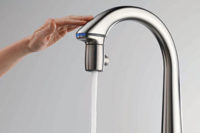Federal legislation that would have drastically reduced the amount of lead in common plumbing products from 8% to 0.2% was sidetracked by some quick lobbying efforts of the Plumbing Manufacturers Institute.
Sen. Jim Jeffords (I-Vt.) introduced the Lead-Free Drinking Water Act on June 29, and by July 20, the bill's lead provisions that affected plumbing products were effectively halted, replaced by a bipartisan amendment to a larger Senate water infrastructure funding bill.
Part of the amendment includes calling for a study on plumbing products with input from PMI.
“We try not to be adversarial,” said Barbara Higgens, PMI's executive director. “We just want to be understood and heard. Many legislators didn't think they had enough hard data on the performance of plumbing products to base decisions on.”
As a result of PMI's contributions, the study will exclude plumbing products that are already exempt from NSF 61, Sec. 9, such as tub fillers, but will focus on other Sec. 9 products, such as kitchen faucets, that people commonly drink from. The study will also cover all Sec. 8 products, such as water meters and backflow preventers. The bill's original language did not draw a clear distinction between fixtures and fittings.
Also, the study will consider the various components that go into a finished faucet.
“A 'faucet' is not simply a single component, but several components that vary in lead content for specific reasons,” said Christian Richter, PMI's lobbyist. PMI has always contended that how a faucet performs is the key factor, rather than focusing attention on the lead content of one particular part of a faucet.
Finally, PMI pressed to be further consulted as the study progresses.
The new developments are a far cry from the bill Jeffords' introduced last June, which contained stringent provisions for faucets, regardless of whether they fill a glass of water or bathtub. For example:
Jeffords' bill also contains other provisions designed to correct lead in service lines that remain unaffected by the amendment to the funding bill. For example, the bill sets timetables for replacing lead public service water lines and requiring better notification for residents when a public utility detects high levels of lead.
Last year in Washington, D.C., for example, some homeowners had lead levels that exceeded the EPA limit by 30 times or more and were not notified for months after the discovery. The cause was largely determined to be a change in the disinfection process that made treated water more corrosive. As a result, the water leached more lead from service lines before reaching the tap.
Jeffords introduced similar legislation after the D.C. lead scare, but that bill never made it out of the Committee on Environment & Public Works.
- Steve Smith and Pat Lenius





